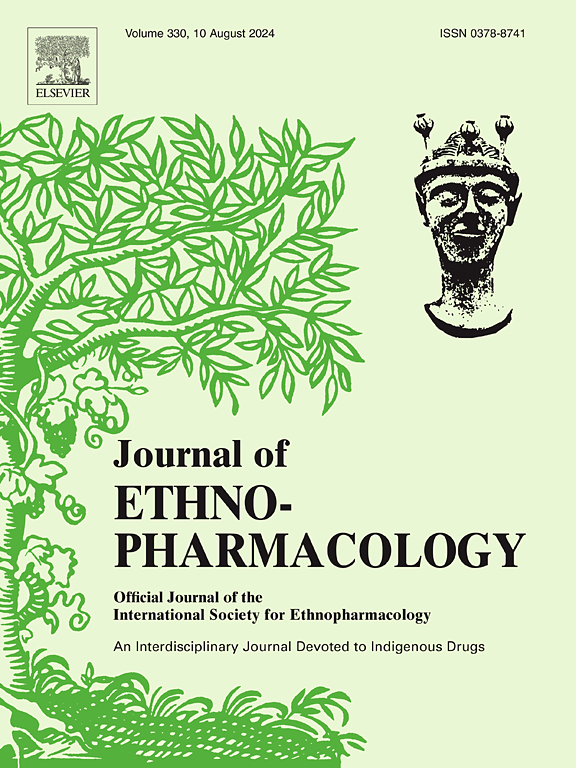Vaccarin treats lactation insufficiency through the ALKBH5-SFRP2-Wnt/β-catenin signaling pathway
IF 4.8
2区 医学
Q1 CHEMISTRY, MEDICINAL
引用次数: 0
Abstract
Ethnopharmacologic significance
Vaccarin, a natural small molecule extracted from Gypsophila vaccaria (L.) Sm., is an active flavonoid glycoside.
Background
Lactation insufficiency refers to insufficient milk secretion in women after childbirth, which affects the feeding of infants and even their development. Our preliminary experiments showed that alkylation repair homolog protein 5 (ALKBH5) was abnormally overexpressed in mammary tissue of lactation deficiency model rats, which played an important role in regulating milk secretion, but the mechanism was not clear, and no research reports were reported in this aspect.
Purpose
The aim of this study was to investigate whether Vaccarin (Vac) treated lactation insufficiency through the ALKBH5-SFRP2-Wnt/β-catenin signaling pathway.
Methods
The lactation insufficiency model rats and primary cultured rat mammary epithelial cells (RMECs) were used as experimental subjects. RT-qPCR, Western blot, RNA Immunoprecipitation, immunofluorescence and related methods were used to study the mechanism of Vac treatment for lactation insufficiency.
Results
Vac effectively increased the milk production, significantly improved the thickness and density of mammary ducts and follicles, and promoted the prolactin (PRL) secretion and the prolactin receptor (PRLR) expression in lactation insufficiency model rats. Vac significantly promoted the expression of FASN, CSN2, and GLUT1. ALKBH5 was upregulated in the mammary gland of model mice, promoting SFRP2 expression and inhibiting the Wnt/β-catenin signaling pathway and the expression of FASN, CSN2 and GLUT1. Furthermore, Vac inhibited the expression of SFRP2 by targeting the ALKBH5, and subsequently activated the Wnt/β-catenin signaling pathway to promote milk secretion in the lactation insufficiency model rats.
Conclusion
Vac promoted milk secretion and improved lactation insufficiency through the ALKBH5-SFRP2-Wnt/β-catenin signaling pathway.

Vaccarin通过ALKBH5-SFRP2-Wnt/β-catenin信号通路治疗泌乳不足
从牛痘菌(Gypsophila vaccaria)中提取的一种天然小分子免疫球蛋白(evaccarin)。Sm。是一种活性类黄酮苷。乳汁分泌不足是指女性分娩后乳汁分泌不足,影响婴儿的喂养甚至发育。我们前期实验发现,烷基化修复同源蛋白5 (ALKBH5)在泌乳不足模型大鼠乳腺组织中异常过表达,在调节乳液分泌中发挥重要作用,但机制尚不清楚,未见这方面的研究报道。目的探讨Vaccarin (Vac)是否通过ALKBH5-SFRP2-Wnt/β-catenin信号通路治疗哺乳功能不全。方法以泌乳不全模型大鼠和原代培养大鼠乳腺上皮细胞(rmac)为实验对象。采用RT-qPCR、Western blot、RNA免疫沉淀、免疫荧光等方法研究Vac治疗泌乳不全的作用机制。结果维密可有效提高泌乳不全模型大鼠的泌乳量,显著改善乳腺导管和卵泡的厚度和密度,促进泌乳素(PRL)分泌和泌乳素受体(PRLR)表达。Vac显著促进FASN、CSN2和GLUT1的表达。ALKBH5在模型小鼠乳腺中上调,促进SFRP2表达,抑制Wnt/β-catenin信号通路及FASN、CSN2、GLUT1的表达。此外,Vac通过靶向ALKBH5抑制SFRP2的表达,进而激活Wnt/β-catenin信号通路,促进泌乳功能不全模型大鼠的泌乳。结论vac通过ALKBH5-SFRP2-Wnt/β-catenin信号通路促进乳汁分泌,改善泌乳不全。
本文章由计算机程序翻译,如有差异,请以英文原文为准。
求助全文
约1分钟内获得全文
求助全文
来源期刊

Journal of ethnopharmacology
医学-全科医学与补充医学
CiteScore
10.30
自引率
5.60%
发文量
967
审稿时长
77 days
期刊介绍:
The Journal of Ethnopharmacology is dedicated to the exchange of information and understandings about people''s use of plants, fungi, animals, microorganisms and minerals and their biological and pharmacological effects based on the principles established through international conventions. Early people confronted with illness and disease, discovered a wealth of useful therapeutic agents in the plant and animal kingdoms. The empirical knowledge of these medicinal substances and their toxic potential was passed on by oral tradition and sometimes recorded in herbals and other texts on materia medica. Many valuable drugs of today (e.g., atropine, ephedrine, tubocurarine, digoxin, reserpine) came into use through the study of indigenous remedies. Chemists continue to use plant-derived drugs (e.g., morphine, taxol, physostigmine, quinidine, emetine) as prototypes in their attempts to develop more effective and less toxic medicinals.
 求助内容:
求助内容: 应助结果提醒方式:
应助结果提醒方式:


